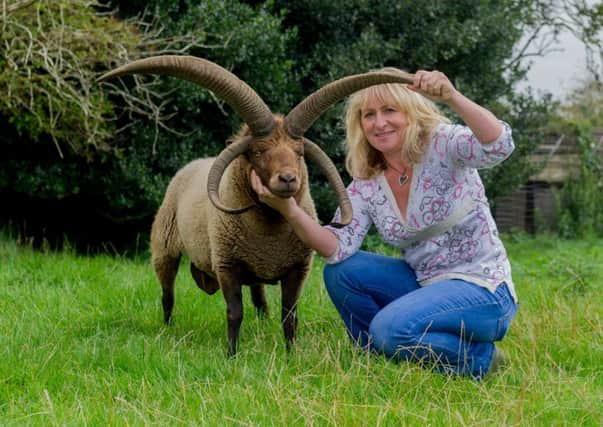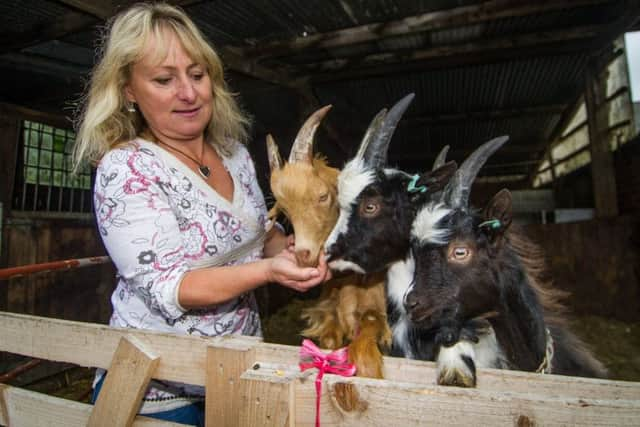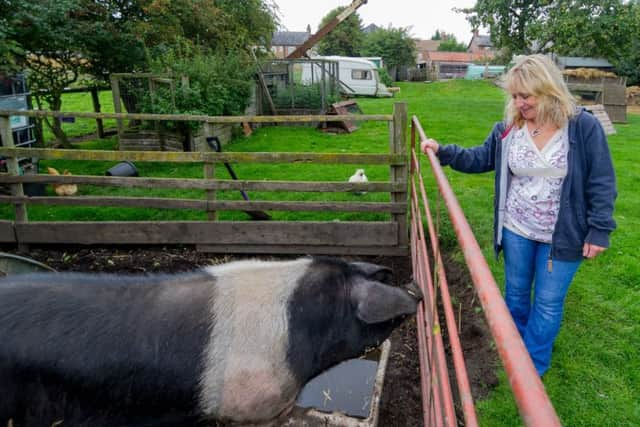Lyn at the forefront of rare breeds survival fight


It’s a use them or lose them scenario and although one of their uses can be to educate the public there are far more breeds than those that populate supermarket shelves.
Many rare and heritage breed farmers recognise that it is only through sale of their meat itself that real longevity can be brought about. That’s certainly the way Lyn Arrowsmith sees the future of her Manx Loaghtan, Boreray, Devon & Cornwall Longwool and Shropshire breeds of sheep; Irish Moiled cattle and British Saddleback pigs at Upper Town Farm in Raskelf where she has lived for 35 years.
Advertisement
Hide AdAdvertisement
Hide AdLyn sees her role as developing a rare breed meat business and informing the public about their flavours and succulence. She’s also found those who are fascinated by rare breeds can sometimes get the wrong end of the stick.


“I’ve had people say I’m making a breed such as our Borerays more rare by making lamb sausages from them, but that’s where they misunderstand. Breeds only truly become rare when nobody sees the value of eating the meat that comes from them.
“Eating rare breed meat more regularly means there is then a greater demand and that encourages those who rear them to continue doing so.
“We won a national sausage competition with our Boreray lamb sausage that included some gentle herbs as we wanted consumers to taste the lamb itself rather than hiding it with spices. Our local butcher Nick Hartley of Tholthorpe developed it by discussing the recipe with my mum, Mary.
Advertisement
Hide AdAdvertisement
Hide Ad“It just goes to highlight that if a breed like the Boreray gets used then there is the potential to breed more and that way make it less rare.


“I now have just over 20 breeding ewes, which may not sound many but with only around 500 registered pedigree ewes it is now one of the biggest.
“They come from an island that is little more than a rock sticking out of the sea off the St Kilda archipelago, the westernmost islands of the Outer Hebrides.”
Lyn started out with rare breeds about 30 years ago alongside her earlier career in show jumping at semi-professional level and training horses.
Advertisement
Hide AdAdvertisement
Hide Ad“We’d originally only had around two and a half acres on the smallholding in the village and had rented some paddocks. We’ve acquired a little more land for what is today’s Raskelf Rare & Heritage Breeds business.


“When we started with the extra paddocks I soon realised we would need sheep to graze as horses are poor grazers. That’s when I made the decision that if I was going to have sheep I’d prefer them to be something unusual rather than six white sheep, so I bought some Manx Loaghtans and joined the Rare Breeds Survival Trust (RBST). I’d always loved going on their stand at he Great Yorkshire Show.
“At that time I was attending a lot of county shows where I was competing in the show jumping and so I started showing the sheep too.
“It was a bit comical at times when we unloaded at a show and out came two show jumpers and six sheep.
Advertisement
Hide AdAdvertisement
Hide Ad“Manx Loaghtan lamb is low in cholesterol and fat and it sells as soon as we have it ready from our flock that runs to around 30 breeding ewes. We won four out of the five Any Other Primitive breed classes at this year’s Great Yorkshire Show. For the past seven years I have been very lucky to have a really wonderful ram that has won everywhere he has been shown.


“He has four horns that are very even, don’t impede his face in any way and he fits the mark spot on. A lot of Manx Loaghtans lack in the back end but he has a good body and stands well.
“I was offered a lot of money for him but it took me 25 years to get one like this!”
Everything comes back to the taste and the meat itself in Lyn’s world.
Advertisement
Hide AdAdvertisement
Hide Ad“Lamb isn’t just lamb and that’s it. Every breed is different when you taste its meat. It’s like buying fine wines. They’re made from different types of grape. Everyone should try specific breeds of lamb, pork and beef.
“We’ve recently taken on Devon & Cornwall Longwools and Shropshires. The Shropshires are quite unique as they won’t eat trees and that means they are useful grazers on such as Christmas tree plantations. Ours are currently on one in Easingwold.
“They also produce good, strong lambs that do well in livestock markets.
“We have British Saddleback pigs, four pedigree sows and a boar producing around 80 pigs a year.
Advertisement
Hide AdAdvertisement
Hide Ad“It’s only a small enterprise as it is with all of my breeds of sheep, cattle, pigs, turkeys, geese and now goats but they bring about a totally different eating experience and it is a myth that rare breeds of pig have poor litters.
“They have between nine to 12 pigs and the taste of their bacon and pork is divine. You also get proper, traditional crackling that commercial pork doesn’t appear to have any longer.”
Lyn went for Irish Moiled when deciding on her beef breed.
“They are hornless and beautiful with stunning markings but the clincher was the taste from a box of beef I ordered. It has a divine, rich, tender flavour.
“I currently have a herd of 18 with four cows, three heifers and a bull. I take progeny through to around 30 months or more and they are all fed and live as naturally as I can possibly make it for them.
“They’re Northern Ireland’s only indigenous breed. I have customers who will just eat vegetables until they are ready.”